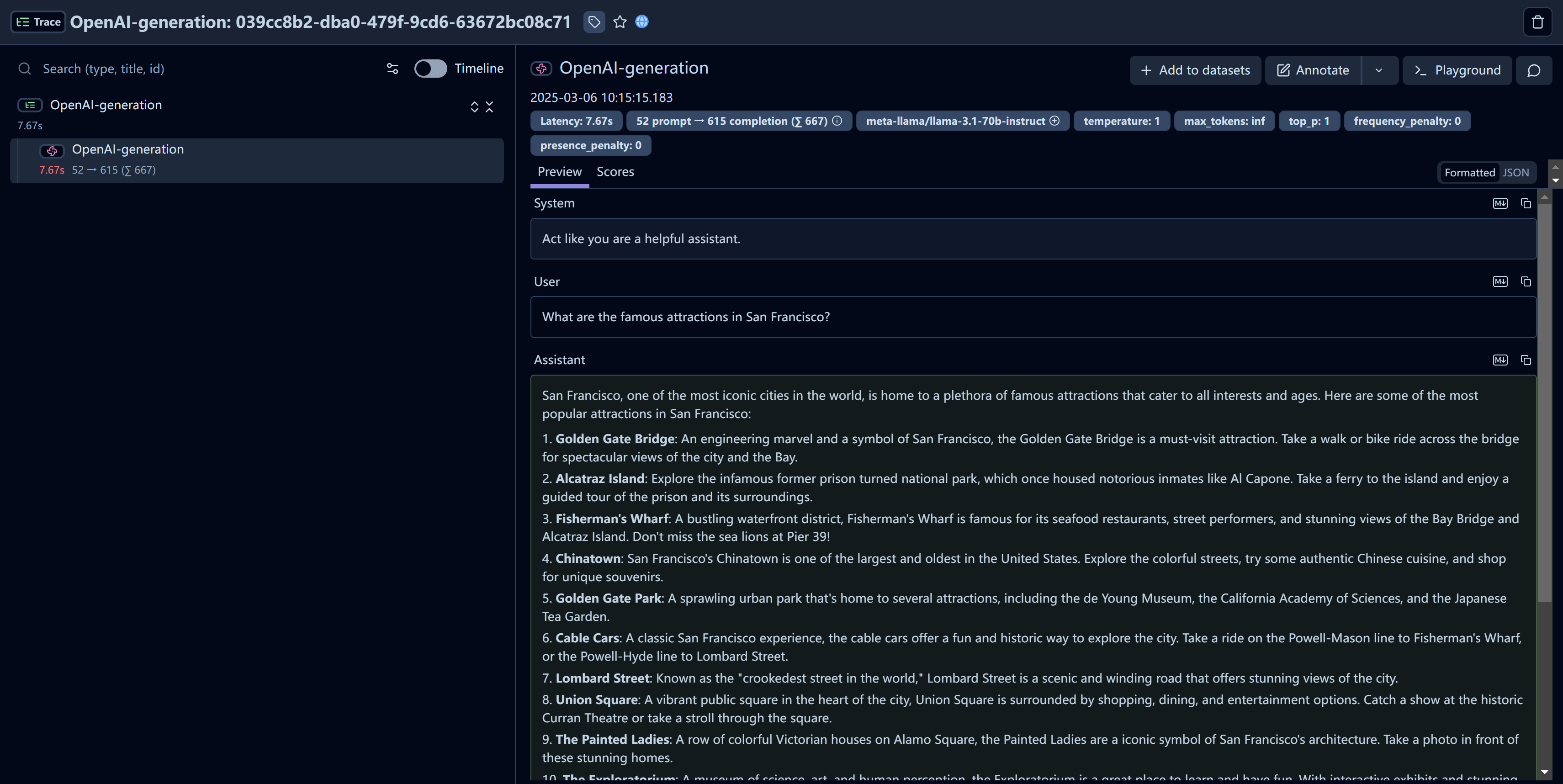Observability for Novita AI with Langfuse
This guide shows you how to integrate Novita AI with Langfuse. Novita AI’s API endpoints for chat, language and code are fully compatible with OpenAI’s API. This allows us to use the Langfuse OpenAI drop-in replacement to trace all parts of your application.
What is Novita AI? Novita AI is an AI cloud platform that helps developers easily deploy AI models through a simple API, backed by affordable and reliable GPU cloud infrastructure. You can try the Novita AI Llama 3 API Demo here.
What is Langfuse? Langfuse is an open source LLM engineering platform that helps teams trace API calls, monitor performance, and debug issues in their AI applications.
Step 1: Install Dependencies
Make sure you have installed the necessary Python packages:
%pip install openai langfuseStep 2: Set Up Environment Variables
import os
# Get keys for your project from the project settings page
# https://cloud.langfuse.com
os.environ["LANGFUSE_PUBLIC_KEY"] = "pk-..."
os.environ["LANGFUSE_SECRET_KEY"] = "sk-..."
os.environ["LANGFUSE_BASE_URL"] = "https://cloud.langfuse.com" # 🇪🇺 EU region
# os.environ["LANGFUSE_BASE_URL"] = "https://us.cloud.langfuse.com" # 🇺🇸 US region
# Get your Novita AI API key from the project settings page
os.environ["NOVITA_API_KEY"] = "..."Step 3: Langfuse OpenAI drop-in Replacement
In this step we use the native OpenAI drop-in replacement by importing from langfuse.openai import openai.
To start using Novita AI with OpenAI’s client libraries, pass in your Novita AI API key to the api_key option, and change the base_url to https://api.novita.ai/v3/openai:
# instead of import openai:
from langfuse.openai import openai
client = openai.OpenAI(
api_key=os.environ.get("NOVITA_API_KEY"),
base_url="https://api.novita.ai/v3/openai",
)Note: The OpenAI drop-in replacement is fully compatible with the Low-Level Langfuse Python SDKs and @observe() decorator to trace all parts of your application.
Step 4: Run An Example
The following cell demonstrates how to call Novita AI’s chat model using the traced OpenAI client. All API calls will be automatically traced by Langfuse.
client = openai.OpenAI(
api_key=os.environ.get("NOVITA_API_KEY"),
base_url="https://api.novita.ai/v3/openai",
)
response = client.chat.completions.create(
model="meta-llama/llama-3.1-70b-instruct",
messages=[
{"role": "system", "content": "Act like you are a helpful assistant."},
{"role": "user", "content": "What are the famous attractions in San Francisco?"},
]
)
print(response.choices[0].message.content)Step 5: See Traces in Langfuse
After running the example model call, you can see the traces in Langfuse. You will see detailed information about your Novita AI API calls, including:
- Request parameters (model, messages, temperature, etc.)
- Response content
- Token usage statistics
- Latency metrics

Interoperability with the Python SDK
You can use this integration together with the Langfuse Python SDK to add additional attributes to the trace.
The @observe() decorator provides a convenient way to automatically wrap your instrumented code and add additional attributes to the trace.
from langfuse import observe, get_client
langfuse = get_client()
@observe()
def my_instrumented_function(input):
# Run your application here
output = my_llm_call(input)
langfuse.update_current_trace(
input=input,
output=output,
user_id="user_123",
session_id="session_abc",
tags=["agent", "my-trace"],
metadata={"email": "user@langfuse.com"},
version="1.0.0"
)
return outputLearn more about using the Decorator in the Python SDK docs.
Next Steps
Once you have instrumented your code, you can manage, evaluate and debug your application:
Interoperability with the Python SDK
- Check the Novita AI Documentation for further details on available models and API options.
- Visit Langfuse to learn more about monitoring and tracing capabilities for your LLM applications.